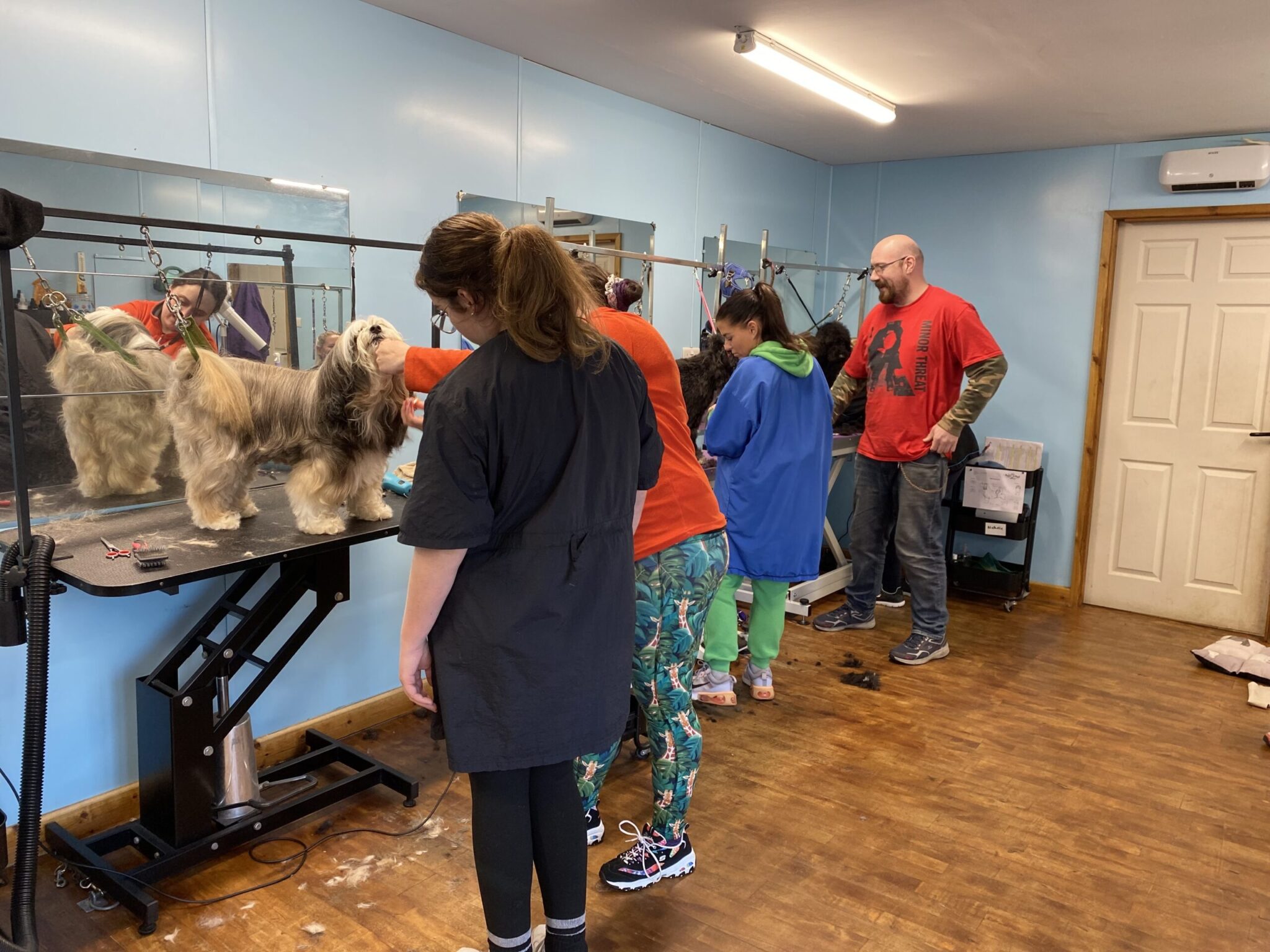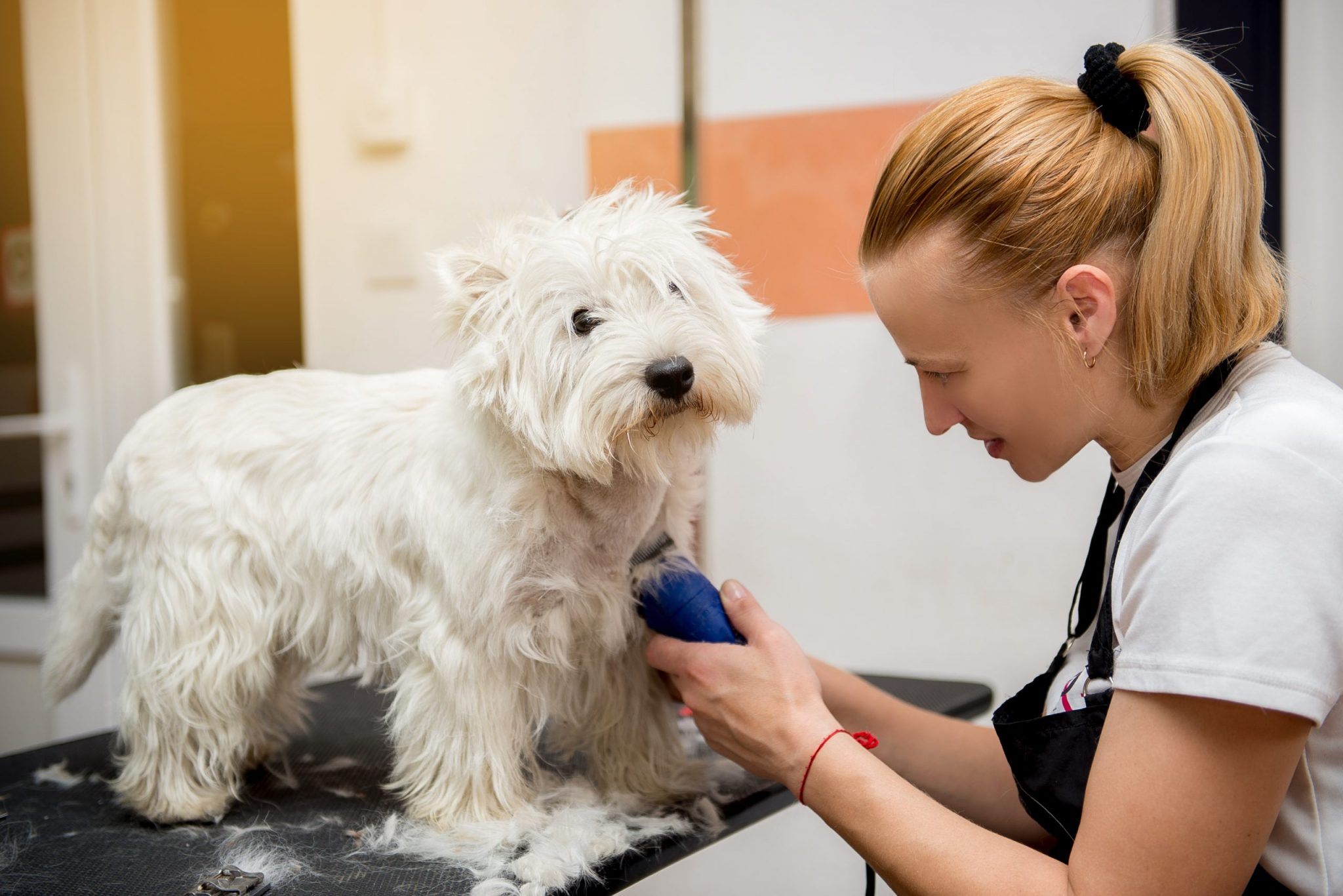The length of time it takes to become a dog groomer can vary depending on several factors, including the type of program or training you choose, the amount of time you can devote to your studies, and your previous experience with dogs.
Dog grooming courses at private learning centres usually last between 2 and 4 weeks and are held Monday through to Friday. If you choose a college course, you’ll likely complete one day a week for a year. Online courses can last anything from between one day to one week, depending on how long you can commit to learning per day.
In addition to formal training programs, some aspiring dog groomers choose to gain experience by working as an apprentice or assistant to an experienced groomer. This type of training can take several months to a year or more, depending on the amount of time you can dedicate to the apprenticeship.
Whichever method you choose to learn dog grooming, it doesn’t mean to say the learning stops once your training is completed. Once you’ve learned the skills and techniques, you’ll spend your whole career perfecting your ability and still be learning along the way.
Overall, the length of time it takes to become a dog groomer can vary widely depending on the specific training program or apprenticeship you choose, as well as your level of dedication and commitment to learning the necessary skills.
How do I become a dog groomer?
Becoming a dog groomer typically involves completing a training program or apprenticeship, gaining experience working with dogs, and adhering to any necessary council requirements. Here are some steps you can take to become a dog groomer:
- Complete a dog grooming course with a reputable provider: Visit the place if you can and make sure you check out reviews. Speak to the centre to get a feel for them at first and check the course will be hands-on, allowing you to groom a live dog model every day you train. It’s also important to make sure you’ll have the model to yourself, not to share with the rest of the class.
- Have a business plan: Make sure you have a place to work from and social media pages ready to go after you complete your training. There’s tons of free advice online about setting up your own business and you can make an excellent living dog grooming once you’ve had chance to build your reputation.
- Stay up-to-date on industry trends: Dog grooming techniques and tools are constantly evolving, so it’s important to stay current with industry trends and continuing education opportunities to improve your skills.
Pros and cons of each training method
Online
Here are some of the pros and cons of learning dog grooming online:
Pros:
- Convenience: One of the biggest advantages of learning dog grooming online is the convenience factor. You can study and learn at your own pace and on your own schedule, which can be particularly helpful if you have other commitments such as work or family obligations.
- Cost: Learning dog grooming online is cheaper than attending a traditional brick-and-mortar school or training program. Many online programs are offered at a lower cost, and you won’t need to pay for transportation or accommodation.
- Access to experts: Online courses often have instructors who are experts in the field of dog grooming and can provide valuable insights and feedback. You may also have access to a community of fellow learners who can provide support and encouragement.
- Wide range of resources: Learning dog grooming online can offer access to a wide range of resources, including videos, articles, and interactive quizzes. This can help you gain a more comprehensive understanding of the subject matter.
Cons:
- Limited hands-on experience: One of the biggest downsides of learning dog grooming online is the lack of hands-on experience. While you may learn the theory and techniques, you won’t have the opportunity to practice on real dogs under the guidance of an instructor.
- Limited networking opportunities: Online learning can be isolating, and you may miss out on the networking opportunities that come with attending a traditional training program or school.
- Requires self-discipline: Learning online requires self-discipline and motivation. You will need to be proactive in setting your own schedule and completing coursework, which may be difficult for some people.
- Limited job prospects: Some employers may prefer to hire dog groomers who have completed traditional training programs or apprenticeships rather than those who have only learned online.
Private learning centres
Here are some of the pros and cons of learning dog grooming through private courses:
Pros:
- Small classes: If the centre is reputable, class size should be small. This is helpful as you’ll receive more attention and guidance than most of the other learning methods.
- Hands-on experience: Private courses often offer more hands-on experience than online courses, which can be beneficial for learners who need practical experience working with dogs.
- Customized curriculum: Private courses can be customized to meet the needs of the learner, which can be helpful for learners who have specific goals or areas they want to focus on.
- Learn quicker: Reputable centres have spent years honing their learning plans to ensure students gain the most knowledge in a short amount of time.
- Ongoing support: Trustworthy private centres set up a system for learners to access free, reliable ongoing advice and support so that when you graduate you can reach out for advice if required.
- Dog models are provided: Good schools have a database of various breeds and temperaments to practise with. This means you’ll get variety of cuts to work on and won’t need to stress about finding your own suitable models each day.
- Personalized feedback: Private courses offer personalized feedback from instructors, which can be helpful for learners who want to improve their skills or technique.
Cons:
- Cost: Private courses can be more expensive than online courses or apprenticeships.
- Availability: Private courses may not be available in all locations, which can limit access to learners who do not live in areas where private courses are offered.
College courses
Here are some of the pros and cons of learning dog grooming through government-funded college courses:
Pros:
- Comprehensive training: As with private centres, a college program in dog grooming provides a comprehensive education that covers everything from basic grooming techniques to more advanced skills like breed-specific grooming
- Networking opportunities: Attending a college program in dog grooming can help you build a network of professional contacts in the industry. You can meet other groomers, dog trainers, veterinarians, and other professionals who may be able to offer you job leads or advice.
- Hands-on experience: Many college programs offer hands-on experience working with dogs, which is essential to becoming a skilled groomer. This experience can help you build your confidence and develop your grooming skills.
- Cost: college courses can be a cheaper alternative to private tuition.
Cons:
- You’ll have to find your own dog models: Unlike private centres, colleges won’t provide dog models and, unless you have excellent contacts in the dog world, or a large pool of dog-owning friends, you may not be able to find enough suitable models, or a wide enough variety of breeds, to practise with. This can undoubtably impact your level of training.
- Time commitment: College programs can take several months or even years to complete, depending on the program. This can be a significant time commitment, especially if you are juggling work or family responsibilities.
- Repeated learning: As most college programs run only one or two days per week, you may find that you’re not absorbing the information as easily as hoped which could result in going over the same things again and again in order to retain the instructions. This can become frustrating and prolong the learning process.
Apprenticeships
Here are some of the pros and cons of learning dog grooming through an apprenticeship:
Pros:
- Hands-on experience: Apprenticeships offer hands-on experience working with dogs under the guidance of an experienced groomer. This can be beneficial for learners who need practical experience working with dogs.
- Real-world skills: Apprenticeships provide learners with real-world skills and knowledge that can be applied to their future careers as dog groomers.
- Networking opportunities: Apprenticeships offer the opportunity to network with other professionals in the field, which can be helpful for learners who want to build their professional network.
Cons:
- Time commitment: Apprenticeships can be a significant time commitment, requiring learners to work long hours and complete a certain number of hours or weeks of training.
- Unpaid: You’ll have to commit a lot of time with no financial reimbursement.
- Limited availability: Apprenticeships are notoriously hard to come by and are offered by a limited number of businesses.
- Limited flexibility: Apprenticeships can be less flexible than other learning options, with learners needing to work on a set schedule.
- Limited curriculum: Apprenticeships may not cover all aspects of dog grooming, and learners may miss out on certain techniques or topics.
- Inadequate learning: there is no guarantee that the experienced groomer will have time to train you. If they do, they may not be an effective teacher. They may not teach you at all and could only have you there to sweep up and make tea. You can’t be sure that you’ll learn hands-on dog grooming in an already established busy salon.
Overall, becoming a dog groomer requires a combination of education, experience, and passion for working with dogs. With dedication and hard work, you can turn your love for dogs into a rewarding career as a dog groomer.




